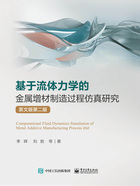
Chapter 2 Investigation of the flow field in Laser-based Powder Bed Fusion manufacturing
◆ Introduction
◆ Simulation model of the L-PBF printer
◆ Simulation results
◆ Conclusions
Laser-based Powder Bed Fusion(L-PBF) is an additive manufacturing(AM) technology that uses a high-energy-density laser to scan through a powder bed and completely melts the metal powder.The layer-by-layer process of melting and solidifying the metal is repeated until the final product is obtained.The environment inside the printer chamber, including the flow field of the protective gas and the particle sputter induced by laser-powder interactions, is essential for product quality.However, this environment limits the development of the L-PBF technology.In this work, we established a multi-physical coupled numerical model for the L-PBF process.The distributions of the argon flow field, the temperature field, and the spatter particles during the printing process were investigated.First, a geometric model and a numerical model of a commercial L-PBF printer was constructed.After verifying the mesh independence of the model, we analyzed the flow field distribution, particularly the flow characteristics above the workbench.Then, a Gaussian heat source model for a moving laser was constructed and the variation of the flow field induced by the moving laser was analyzed.Subsequently, we constructed a movable particle-injection model to study the trajectory and deposition of the spatter particles at different laser powers and various initial velocities of the spatter particles.The results show that, the proposed L-PBF printer chamber structure will ensure the stability of the flow above the workbench.The moving laser induced velocity disturbance inside the L-PBF printer is negligible.Particle deposition inside the printer chamber strongly depends on laser power, injection velocity, and the direction of the particle.A large percentage of the injected particles are deposited on the workbench, which pollutes the powder bed.